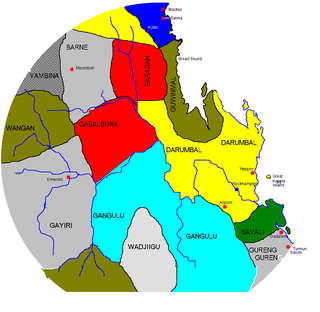This page is based on this
Wikipedia article Text is available under the
CC BY-SA 4.0 license; additional terms may apply.
Images, videos and audio are available under their respective licenses.
The Tagalag are an indigenous Australian tribe of northern Queensland.

The Kangulu, also written Gangulu, is an aboriginal tribe from the Mount Morgan area in Queensland, Australia.
The Kuungkari are an indigenous Australian people of Queensland. They are to be distinguished from the Kunggari.
The Geynyon, also written Keinjan, are an indigenous Australian people of southern Queensland.
The Bitjara or Bithara were an indigenous people of the state of Queensland. They spoke a dialect of the Ngura language. They are not to be confused with the Warrego River Pitjara or the Badjiri of the Paroo River.
The Punthamara were an indigenous Australian people of the state of Queensland.
The Mbara, or Mitjamba, were an indigenous Australian people of the state of Queensland.
The Maikulan were an indigenous Australian people of the state of Queensland. They have sometimes been confused with the Maithakari.
The Kambuwal were an indigenous Australian people of the state of Queensland.
The Kunandaburi or Karendala (Garandala) were an indigenous Australian people of the state of Queensland.
The Wulpura were an indigenous Australian people of the state of Queensland.
Their language, Kuku Waldja, has been listed as a dialect of Kuku Yalanji, but there does not appear to be any data available.
The Gugu Rarmul were an indigenous Australian people of the state of Queensland, one of several whose speech was called Gugu Yawa.
The Julaolinja were an indigenous Australian people of the state of Queensland.
The Yangaa were an indigenous Australian people of the state of Queensland. They may be the same as the Nyangga. They are not to be confused with the Yangga.
The Yagalingu were an indigenous Australian people of the state of Queensland.
Their language may have been a dialect of Bidjara.
The Marulta were an indigenous Australian people of the state of Queensland.
The Djankun were an indigenous Australian people of the state of Queensland,
The Juru (Yuru) are an indigenous Australian people of the state of Queensland
The Kokopera, also written Koko Bera, are an indigenous Australian people of the Cape York Peninsula of Northern Queensland.
The Paaruntyi are an indigenous Australian people of the state of New South Wales. They are not to be confused with the Parrintyi.




